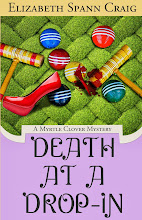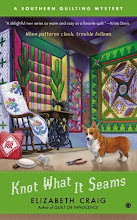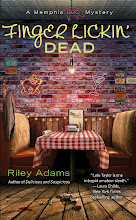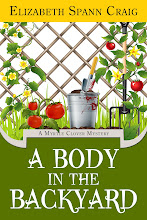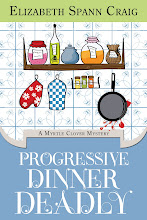by Elizabeth S. Craig, @elizabethscraig
I’m new to outlining and sometimes
there’s an element that’s missing when I draft outlines—complexity.
I think that’s because I usually add more
layers to my books after the first draft is finished. Unfortunately, I won’t have finished the
first draft when I submit an outline to my editor...I won't even have started the book... and it won’t occur to me to add
the complexity into the outline before I send it (at least, it hasn’t
before). This means that I ordinarily
get feedback on my outlines that state “could you please add some complexity to
this mystery?”
(Note to self: it will save us all a lot
of time if I take that step before submitting the next outline.)
I’m imagining that I’m not the only one
who gets this kind of feedback from an editor…at least, I hope I’m not. Luckily, there are quite a few ways to make a
mystery less cut-and-dried or easily solved.
Some ideas:
More
suspects. You have to be careful here, because if you have too many
suspects, then readers can get lost. If
you already have quite a few suspects, then really take a look at them. Is one of them less-likely as the
murderer? Can you add to their motive or
give them more opportunity to have committed the crime? Can you, in other words, make that suspect
appear more suspicious?
A motive
that is different from the motive you’ve originally promoted as the one tied to the murder. You’ve got greed or
financial gain as the motive for the murder—with a cast of characters who all
have something to gain from the victim’s death.
But you could suddenly reveal either a different motive or a suspect with
an additional motive—revenge, anger,
ambition, jealousy. Maybe the suspect is
trying to cover up a different crime.
Point to a
different suspect toward the end of the story. One way to help make the killer’s identity
more of a surprise is to subtly direct readers to a completely different
suspect very close to the end of the book.
Have your
suspects both lie and tell truths. In
my books, I’ve got my suspects feeding my sleuths a variety of different
information. Some of it leads the sleuth
to clues. Some of it functions as a red
herring. At times, it’s hard for the
sleuth to distinguish the truth from the lies and it makes it more difficult
for her to solve the mystery when she isn’t sure the information she’s
receiving is trustworthy—or if the source of it is.
Obfuscate.
Give suspects secrets that have nothing to do with the murder. One reason that your suspects would lie is if they were trying to protect
their secrets. Most people have things
they’d rather no one else knew about.
This is especially easy to write if your book is set in a small
town—folks don’t want the whole town to know their business when they have to
live and work closely with a small number of people. There are old scandals,
petty crimes, or illicit relationships they’d like to keep to themselves. These secrets function as roadblocks, red
herrings, and detours for our sleuths.
Another
victim. Just when your readers
think they’ve nailed the right suspect—kill the suspect. :) Or, kill another
likely suspect and give the most likely suspect a great alibi. On that note…
Locked
rooms, iron-tight alibis. If you
add a bit of impossibility to the story, it not only adds complexity, it helps break up endless suspect interviews. Then
you can gradually offer glimpses how these situations are possible.
Parallel
subplots. Bonus points if you can
connect a subplot that develops a character to the mystery somehow. Maybe it can get the sleuth out of hot water
or provide a clue to solving the case.
Tie-ins are interesting.
Basically—what can you do to make this
story twist a little? Brainstorm ways to
play havoc with the sleuth’s investigation.
Can you derail it temporarily? Send it off in a different
direction? There are ways to add
complexity without taking it so far as to frustrate the reader (which we don’t want).
Some of these fixes will also work with
other genres. You can expand on it,
too. How do you see writers in your
genre add complexity or twists to their stories?
Image: MorgueFile: Ladyheart






